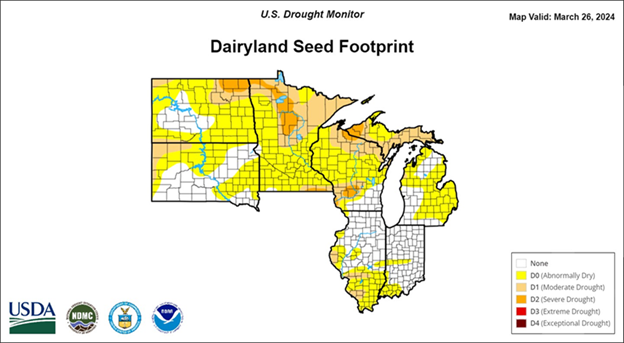Herbicidal Carryover and Current Conditions
BY Dairyland Seed Agronomy Team
Soil moisture is a primary driver of the microbial and chemical degradation of herbicides. Dry weather conditions allow herbicides to persist for a longer period within the soil profile, potentially causing herbicide carryover. A few different factors should be on your radar to prevent potential management challenges as you prepare for your 2024 season.
Herbicide breakdown is an extremely complex process. The natural flora and fauna of microorganisms either ingest or must be closely associated with the soil microbes for degradation to happen. Soil microbes are most active in soils with 50-100 percent field capacity, so in-season rainfall is a critical driving factor in herbicide degradation via this pathway.
Other factors that can contribute to herbicide breakdown include the following, but are not limited to:
- Soil characteristics (texture, organic matter, pH)
- Environmental conditions
- Total amount and distribution of rainfall
- Herbicide chemistry and half-life
- Herbicide rate and application frequency
- Herbicide application date
- Rotational crop sensitivity to herbicide
Corn and soybean growers should be looking at the current drought monitor, last year’s dryness, future weather models and recalling the things that influence herbicidal carryover potential to prepare for a successful 2024. They should also be cognizant of the exact herbicide products applied, the rate, and the application timing for crop rotational restrictions from the 2023 crop year. Pay close attention to herbicide products applied that have a re-cropping interval of nine months or longer. The susceptibility of herbicide carryover of the of in-bound crop is greatly influenced by these factors.
Early planting opportunities may increase this risk, so be certain to review last year’s applications and be proactive in reducing carryover potential in the 2024 crop. 
https://ipm.missouri.edu/croppest/2024/3/herbicide_carryover_concerns_soybean-kb/
https://www.agweb.com/news/crops/crop-production/agronomists-worry-moisture-deficits-will-contribute-herbicide-carryover

Brian Weller
Western Region
507.456.3034

Rod Moran
Western Region
507.456.3034

Dan Ritter
Central Region
219.863.0583

Branden Furseth
Northern Region
608.513.4265

Mark Gibson
Eastern Region
260.330.8968

Amanda Goffnett
Eastern Region
989.400.3793

Ryan Mueller
Eastern Region
989.400.3793
